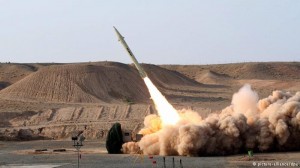Special to WorldTribune.com
LONDON — The United Nations has determined that Iran was nearly ready to open a ballistic missile site.
A UN panel has concluded that Iran was expanding its ballistic missile program and building facilities for space launches. The UN Panel of Experts drafted a report that identified two major missile sites in Iran.

“A new missile launch site 40 kilometers from the city of Shahrud was identified in August 2013,” the 49-page report said. “A larger launch complex is assessed to be close to completion at the Imam Khomeini Space Center at Semnan for ballistic missiles and satellite launch vehicles.”
In June 2013, Iran opened the Imam Sadeq Observation and Monitoring Center to track missiles and other objects in space. The UN report did not detail activities at the new facility.
“Analysis of Iran’s ballistic missile program remains a challenge,” the report said. “With the exception of several launches, periodic displays of hardware and one recent revelation of a new ballistic launch facility, the program is opaque and not subject to the same level of transparency that Iran’s nuclear activities are under IAEA [International Atomic Energy Agency] safeguards.”
The confidential study, first reported by the Reuters News Agency on May
16, came amid tough negotiations between Iran and the P5+1 to reach a
nuclear agreement before the July 20 deadline. The United States and
European Union have demanded that the agreement also address Iran’s missile
arsenal, the largest in the Middle East.
In 2010, the Security Council called on Iran to stop developing
missiles that could contain a nuclear warhead. The Teheran regime has
consistently rejected any restrictions on its missile program.
The UN report cited Iran’s drive to expand its missile program,
including the development of an intercontinental ballistic missile. But the
panel said Teheran might have reduced efforts to procure components as it
sought to reach a nuclear agreement that would end sanctions.
“Among the most important items Iran is reportedly seeking are metals as
well as components for guidance systems and fuel,” the report said.
“Similarities between Iran’s ballistic missiles and space programs can make
it difficult for states to distinguish the end-uses of procured items.”
The report cited the launch of what was termed a “new-generation,
long-range ballistic missile” in February 2014. The missile, called Barani,
was said to contain multiple warheads and meant to overcome defense systems.
At the same time, Iran appeared to have suspended tests of its
solid-fueled Sejil-2 intermediate-range ballistic missile. Sejil, last seen
in a parade in 2013, has not been launched since 2011.
“Iran may also have decided to suspend further testing which could be
interpreted as inconsistent with the spirit of the [P5+1] negotiations,” the
report said.

You must be logged in to post a comment Login